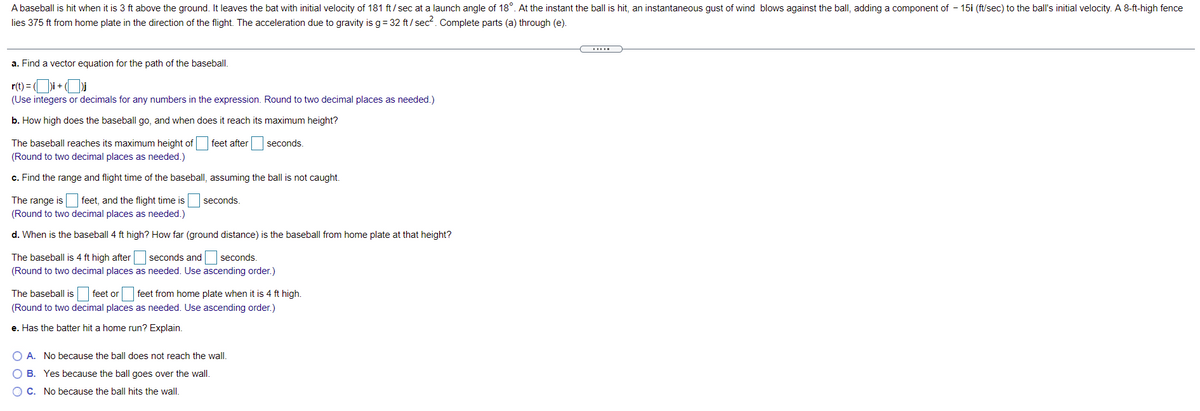A baseball is hit when it is 3 ft above the ground. It leaves the bat with initial velocity of 181 ft/sec at a launch angle of 18°. At the instant the ball is hit, an instantaneous gust of wind blows against the ball, adding a component of - 15i (f/sec) to the ball's initial velocity. A 8-ft-high fence lies 375 ft from home plate in the direction of the flight. The acceleration due to gravity is g= 32 ft/sec. Complete parts (a) through (e). ... a. Find a vector equation for the path of the basebal. r(t) = C • O (Use integers or decimals for any numbers in the expression. Round to two decimal places as needed.) b. How high does the baseball go, and when does it reach its maximum height? The baseball reaches its maximum height of feet after seconds. (Round to two decimal places as needed.) c. Find the range and flight time of the baseball, assuming the ball is not caught. The range is feet, and the flight time isO seconds. (Round to two decimal places as needed.)
A baseball is hit when it is 3 ft above the ground. It leaves the bat with initial velocity of 181 ft/sec at a launch angle of 18°. At the instant the ball is hit, an instantaneous gust of wind blows against the ball, adding a component of - 15i (f/sec) to the ball's initial velocity. A 8-ft-high fence lies 375 ft from home plate in the direction of the flight. The acceleration due to gravity is g= 32 ft/sec. Complete parts (a) through (e). ... a. Find a vector equation for the path of the basebal. r(t) = C • O (Use integers or decimals for any numbers in the expression. Round to two decimal places as needed.) b. How high does the baseball go, and when does it reach its maximum height? The baseball reaches its maximum height of feet after seconds. (Round to two decimal places as needed.) c. Find the range and flight time of the baseball, assuming the ball is not caught. The range is feet, and the flight time isO seconds. (Round to two decimal places as needed.)
Algebra & Trigonometry with Analytic Geometry
13th Edition
ISBN:9781133382119
Author:Swokowski
Publisher:Swokowski
Chapter6: The Trigonometric Functions
Section6.4: Values Of The Trigonometric Functions
Problem 44E
Related questions
Question

Transcribed Image Text:A baseball is hit when it is 3 ft above the ground. It leaves the bat with initial velocity of 181 ft/ sec at a launch angle of 18°. At the instant the ball is hit, an instantaneous gust of wind blows against the ball, adding a component of - 15i (ft/sec) to the ball's initial velocity. A 8-ft-high fence
lies 375 ft from home plate in the direction of the flight. The acceleration due to gravity is g= 32 ft/ sec². Complete parts (a) through (e).
a. Find a vector equation for the path of the baseball.
r(t) = Di+
(Use integers or decimals for any numbers in the expression. Round to two decimal places as needed.)
b. How high does the baseball go, and when does it reach its maximum height?
The baseball reaches its maximum height of
feet after
seconds.
(Round to two decimal places as needed.)
c. Find the range and flight time of the baseball, assuming the ball is not caught.
The range is feet, and the flight time is
(Round to two decimal places as needed.)
seconds.
d. When is the baseball 4 ft high? How far (ground distance) is the baseball from home plate at that height?
The baseball is 4 ft high after seconds and seconds.
(Round to two decimal places as needed. Use ascending order.)
The baseball is feet or feet from home plate
it is 4 ft high.
(Round to two decimal places as needed. Use ascending order.)
e. Has the batter hit a home run? Explain.
O A. No because the ball does not reach the wall.
B. Yes because the ball goes over the wall.
O C. No because the ball hits the wall.
Expert Solution
This question has been solved!
Explore an expertly crafted, step-by-step solution for a thorough understanding of key concepts.
This is a popular solution!
Trending now
This is a popular solution!
Step by step
Solved in 3 steps with 3 images

Recommended textbooks for you

Algebra & Trigonometry with Analytic Geometry
Algebra
ISBN:
9781133382119
Author:
Swokowski
Publisher:
Cengage

Algebra and Trigonometry (MindTap Course List)
Algebra
ISBN:
9781305071742
Author:
James Stewart, Lothar Redlin, Saleem Watson
Publisher:
Cengage Learning

Trigonometry (MindTap Course List)
Trigonometry
ISBN:
9781305652224
Author:
Charles P. McKeague, Mark D. Turner
Publisher:
Cengage Learning

Algebra & Trigonometry with Analytic Geometry
Algebra
ISBN:
9781133382119
Author:
Swokowski
Publisher:
Cengage

Algebra and Trigonometry (MindTap Course List)
Algebra
ISBN:
9781305071742
Author:
James Stewart, Lothar Redlin, Saleem Watson
Publisher:
Cengage Learning

Trigonometry (MindTap Course List)
Trigonometry
ISBN:
9781305652224
Author:
Charles P. McKeague, Mark D. Turner
Publisher:
Cengage Learning

Trigonometry (MindTap Course List)
Trigonometry
ISBN:
9781337278461
Author:
Ron Larson
Publisher:
Cengage Learning

Linear Algebra: A Modern Introduction
Algebra
ISBN:
9781285463247
Author:
David Poole
Publisher:
Cengage Learning